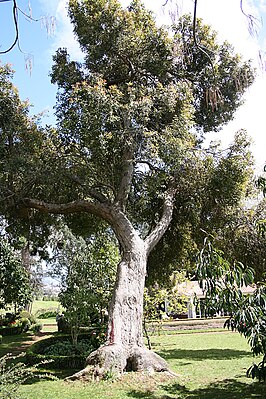Corymbia ficifolia
| Corymbia ficifolia | ||||||||||||
|---|---|---|---|---|---|---|---|---|---|---|---|---|

Corymbia ficifolia |
||||||||||||
| Systematics | ||||||||||||
|
||||||||||||
| Scientific name | ||||||||||||
| Corymbia ficifolia | ||||||||||||
| ( F.Muell. ) KDHill & LASJohnson |
Corymbia ficifolia is a species of the genus Corymbia withinthe myrtle family (Myrtaceae). It occurs in the southwest of Western Australia and is called "Red-flowering Gum" there.
description
Appearance and leaf
Corymbia ficifolia grows as a bushy tree that reaches heights of 2 to 10 meters. The bark remains on the entire tree, is gray-brown to red-brown, checkerboard-like or short-fibered and has glands. There are oil glands in the medulla.
In Corymbia ficifolia , heterophyllia is present. The leaves are always divided into a petiole and a leaf blade. The leaf blade on young specimens is lanceolate to ovate and has stiff simple hairs and stiff glandular hairs. The leaf blade on medium-old plants is lanceolate to elliptical, straight, entire and dull green. The leaf stalk, which is narrowly flattened in cross section or sometimes channel-shaped, is 10 to 20 millimeters long. The leaf blade on adult specimens is relatively thick, with a length of 7.5 to 15 cm and a width of 3 to 5 cm wide - lanceolate to ovate, straight, with a tapering or rounded blade base and a pointed, pointed or blunt upper end. The top and bottom of the leaves are colored differently shiny green. The raised or barely discernible side nerves leave the median nerve at small intervals at an obtuse angle. On each half of the leaf there is a pronounced, continuous, so-called intramarginal nerve; it runs at a small distance along the edge of the leaf. The cotyledons ( cotyledons ) are almost circular.
Inflorescence and flower
The flowering period in Western Australia extends from December or January to May. At the end of an inflorescence stem with a length of 15 to 25 millimeters in cross section is a compound inflorescence consisting of doldy partial inflorescences each with three to seven flowers.
The club-shaped or top-shaped flower bud is 9 to 13 millimeters long, 6 to 8 millimeters wide and is not floured or frosted blue-green. The sepals form a calyptra that remains until the flower ( anthesis ) opens. The smooth calyptra is kneecap-shaped and beak-shaped and narrower than the smooth flower cup (hypanthium). The flowers are cream to pink or red.
Fruit and seeds
The stalked fruit is 25 to 35 millimeters long and 20 to 30 millimeters in diameter egg-shaped and four-fan. The disc is indented and the fruit compartments are included.
The regular or laterally flattened, boat-shaped or egg-shaped seed has a net-like, matt to silk-matt, red-brown seed coat. The hilum is at the top of the seed.
Occurrence
The natural range of Corymbia ficifolia are exclusively the south coast and coastal areas east and west of Albany in Western Australia . In Western Australia, Corymbia ficifolia occurs in the independent administrative districts of Albany , Denmark , Manjimup and Plantagenet in the South West and Great Southern regions .
Corymbia ficifolia thrives on white and gray sandy or sandy loam soils , often with gravel. It occurs preferentially on slopes.
Taxonomy
It was first published in 1860 by Ferdinand von Mueller under the name ( Basionym ) Eucalyptus ficifolia F. Muell. in Fragmenta Phytographiae Australiae , Volume 2 (13), p. 15. The type material has the inscription Prope litora aestuarii “Broken Inlet” Novae Hollandiae austro occidentalis. Mx. on. The new combination to Corymbia ficifolia (F.Muell.) KDHill & LASJohnson took place in 1995 under the title Systematic studies in the eucalypts. 7. A revision of the bloodwoods, genus Corymbia (Myrtaceae) in Telopea , Volume 6 (2-3), p. 245. Another synonym for Corymbia ficifolia (F. Muell.) KDHill & LASJohnson is Eucalyptus ficifolia var. Carmina Blakely .
use
Corymbia ficifolia is used as an ornamental plant in gardens and parks, as well as on roadsides. There are varieties.
Individual evidence
- ↑ a b Specimen search results: Corymbia ficifolia at Australia's Virtual Herbarium. Council of Heads of Australasian Herbaria . Retrieved February 4, 2013
- ↑ a b c d e Corymbia ficifolia in the Western Australian Flora . Retrieved February 4, 2013.
- ↑ a b c d APNI = Australian Plant Name Index. Center for Plant Biodiversity Research. Australian Government. Retrieved February 4, 2013
- ↑ a b c d e f Corymbia ficifolia at EucaLink - A Web Guide to the Eucalypts . Retrieved February 4, 2013
- ↑ Corymbia calophylla at Tropicos.org. Missouri Botanical Garden, St. Louis, accessed January 30, 2013.
- ↑ Rafaël Govaerts (Ed.): Corymbia ficifolia. In: World Checklist of Selected Plant Families (WCSP) - The Board of Trustees of the Royal Botanic Gardens, Kew . Retrieved February 4, 2013.




